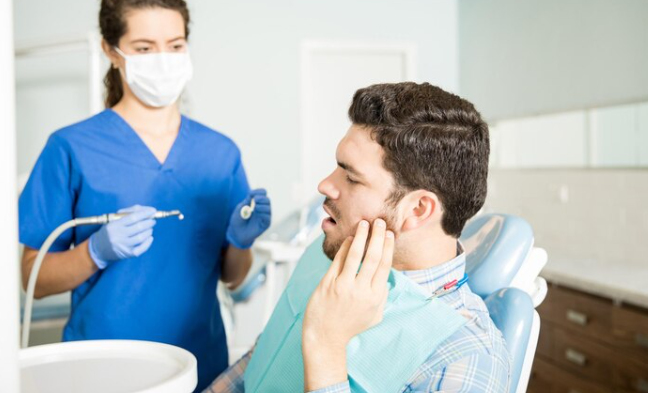Jaw pain can be a significant issue that affects daily life, from eating and speaking to simply opening your mouth. One often overlooked cause of jaw pain is malocclusion, a misalignment of the teeth and jaws that can lead to various discomforts and complications. Understanding the relationship between jaw pain and malocclusion, and knowing how a family dentist can help, can offer relief and restore comfort to those affected.
What Causes Jaw Pain and How Is It Related to Malocclusion?
Jaw pain is a common issue that many people face, and it often originates from problems with the temporomandibular joint (TMJ). This joint, which connects the jawbone to the skull, is crucial for daily functions such as chewing and speaking. When there are issues with this joint, pain and discomfort can arise.
Malocclusion, or poor alignment of the teeth and bite, can significantly worsen TMJ-related problems. Here’s how malocclusion contributes to jaw pain:
- Uneven Stress on the Jaw: Misaligned teeth can force the jaw to move in unnatural ways. This irregular movement can place uneven stress on the TMJ and surrounding muscles, leading to pain and discomfort.
- Strain on Muscles and Joints: When teeth don’t align properly, the muscles that control jaw movement have to work harder. This extra strain can cause muscle fatigue and joint pain, which often manifests as jaw pain.
- Grinding and Clenching: People with misaligned teeth might unconsciously grind or clench their teeth, especially during sleep. This behavior, known as bruxism, adds additional pressure on the TMJ and can exacerbate pain and lead to TMJ disorders.
- Headaches and Ear Pain: The stress on the TMJ from malocclusion can radiate to other areas, causing headaches and ear pain. This is due to the interconnected nature of the muscles and nerves in the head and jaw.
Addressing malocclusion is crucial for alleviating jaw pain and preventing further complications. A family dentist can help identify the cause and recommend effective treatments to restore balance and comfort.
How Can a Family Dentist Diagnose and Treat Jaw Pain Caused by Malocclusion?
A family dentist is essential in diagnosing and treating jaw pain linked to malocclusion. Here’s how they can help:
- Comprehensive Dental Examination: The first step involves a detailed dental exam. The dentist will carefully assess the alignment of your teeth and jaw to identify any irregularities. They’ll also evaluate your bite to check if your teeth come together properly.
- Assessment of TMJ Function: The dentist will look for signs of TMJ dysfunction, such as tenderness, clicking sounds, or difficulty moving the jaw. This evaluation helps determine if TMJ issues are contributing to your jaw pain.
- Diagnostic Tools: To get a clearer view of your jaw and teeth, the dentist may use X-rays or digital imaging. These tools provide detailed images of your jaw structure and teeth alignment, helping to pinpoint the exact causes of your discomfort.
- Customized Treatment Plan: After diagnosing the issue, the dentist will create a personalized treatment plan. This plan addresses both the symptoms and the root causes of your jaw pain.
- Orthodontic Treatment: If malocclusion is the cause, the dentist might recommend braces or clear aligners to realign your teeth and improve your bite. Proper alignment helps reduce stress on the TMJ and surrounding muscles.
- TMJ Therapy: The dentist may suggest therapies to relieve TMJ pain, such as bite guards, muscle relaxants, or specific exercises to strengthen jaw muscles.
- Pain Management: Strategies to manage pain and discomfort, such as hot or cold compresses, medications, or relaxation techniques, might also be recommended.
By addressing both the alignment issues and the associated symptoms, a family dentist can effectively help relieve jaw pain and improve overall oral health.
What Are Common Treatments a Family Dentist Offers for Malocclusion-Related Jaw Pain?
Family dentists provide a range of treatments to manage malocclusion and the related jaw pain. Here’s how they typically address these issues:
- Orthodontics: One of the most common treatments for malocclusion involves orthodontics. This includes:
- Braces: Traditional metal braces are used to gradually shift misaligned teeth into their correct positions. Over time, this realignment helps improve bite and reduce stress on the jaw.
- Clear Aligners: For a more discreet option, clear aligners like Invisalign are used. These removable trays gradually move the teeth into proper alignment without the use of brackets and wires.
- Splints and Night Guards: When malocclusion leads to significant TMJ issues or teeth grinding (bruxism), a dentist may recommend:
- Splints: These are custom-made appliances that fit over the teeth to prevent grinding and clenching. They help to distribute the bite force evenly, reducing muscle strain and jaw pain.
- Night Guards: Similar to splints, night guards are worn while sleeping to protect the teeth from the effects of grinding and clenching. They help to alleviate pressure on the TMJ and prevent further discomfort.
- Collaborative Care: For more severe cases of malocclusion where conventional treatments may not be enough, a family dentist might collaborate with:
- Orthodontists: Specialists who focus on complex alignment issues, providing advanced treatment options.
- Oral Surgeons: In cases requiring surgical intervention, oral surgeons may be involved to correct significant bite discrepancies and address underlying structural issues.
By offering these treatments, family dentists aim to alleviate jaw pain, improve function, and enhance overall oral health.
How Affordable Are the Solutions Provided by Family Dentists for Jaw Pain Due to Malocclusion?
Cost is an important consideration for many when seeking treatment for jaw pain related to malocclusion. Family dentists often provide a range of options to fit different budgets and needs. Basic treatments, such as dental evaluations and splints, are generally more affordable and may be covered by insurance. Orthodontic treatments, while more of an investment, offer long-term benefits and can often be financed through flexible payment plans.
It’s also worth noting that investing in treatment to correct malocclusion and alleviate jaw pain can prevent more severe issues and potentially higher costs down the road. Addressing these problems early on can lead to better outcomes and reduce the need for more extensive and costly interventions later.
A family dentist is well-equipped to diagnose and treat jaw pain caused by malocclusion with a variety of affordable solutions. By understanding the connection between malocclusion and jaw pain, and exploring the treatments available, you can take proactive steps toward relieving discomfort and improving your overall oral health.
Why Cascade Dental Is Your Best Choice for Addressing Jaw Pain and Malocclusion
We at Cascade Dental are dedicated to offering effective, personalized solutions to alleviate the discomfort caused by malocclusion, as we comprehend the debilitating nature of jaw pain. Our team of professionals employs a comprehensive approach to dental care, guaranteeing that each patient receives a personalized treatment plan and complete evaluation.
We employ the most advanced diagnostic technology to precisely evaluate your mandible alignment and identify any underlying issues that may be contributing to your discomfort. Our skilled professionals are adept at recommending and implementing advanced orthodontic treatments, including braces and clear aligners, to correct misalignments and improve bite function.
Beyond orthodontics, we also offer comprehensive TMJ therapy to address any related joint issues. Our goal is to provide you with relief while ensuring affordability and accessibility to high-quality care. At Cascade Dental, we are dedicated to improving your overall well-being and ensuring you leave our office with a healthier, more comfortable smile.
Frequently Asked Questions About Malocclusion and Jaw Pain
How Much Does Treatment for Malocclusion Typically Cost?
The cost of treating malocclusion can vary depending on the complexity of the case and the type of treatment required. Generally, orthodontic treatments like braces or clear aligners range from $3,000 to $7,000. For more advanced cases that may require additional procedures or TMJ therapy, the cost could be higher. At Cascade Dental, we offer flexible payment plans and financing options to make treatment more affordable.
How Long Will It Take to See Results from Orthodontic Treatment?
The degree of the malocclusion and the type of treatment selected determine how long orthodontic therapy will take. Patients should typically show noticeable improvement in 12 to 24 months. A customized timetable based on your unique requirements and objectives will be provided by our staff at Cascade Dental.
Will Insurance Cover the Cost of Malocclusion Treatment?
Orthodontic treatments are often covered by dental insurance plans, though the exact amount of coverage varies. It’s a good idea to find out what your benefits and out-of-pocket expenses are from your insurance company. Our administrative team is available to help with insurance claims and address any inquiries you may have regarding coverage.
How Do I Know If I Need to See a Family Dentist for My Jaw Pain?
If you’re experiencing persistent jaw pain, headaches, or difficulty in chewing, it’s advisable to consult with a family dentist. Early diagnosis and treatment can prevent further complications and improve your quality of life. At Cascade Dental, we offer comprehensive evaluations to determine the cause of your discomfort and provide appropriate solutions.
Ready to Find Relief? Get in Touch with Cascade Dental Today!
If you’re struggling with jaw pain or malocclusion, don’t wait to get the help you need. Contact Cascade Dental to schedule your consultation and discover how our personalized, affordable treatments can make a difference. Call us or visit our website to book an appointment. Let’s work together to achieve a healthier, more comfortable smile!



